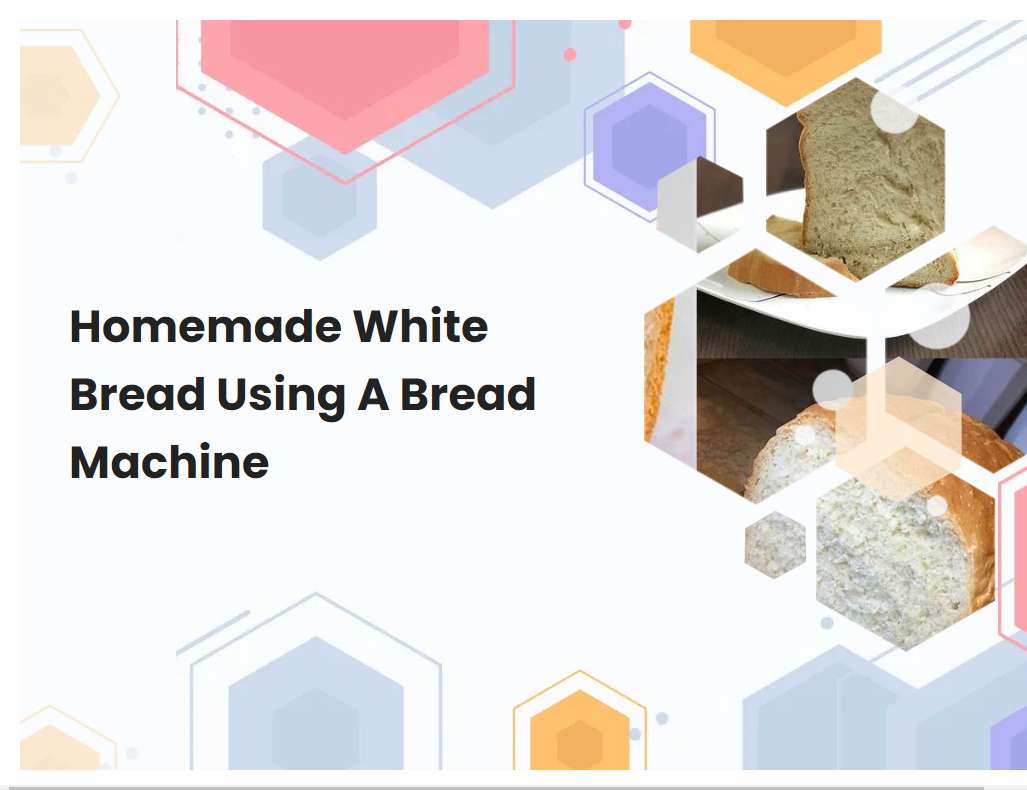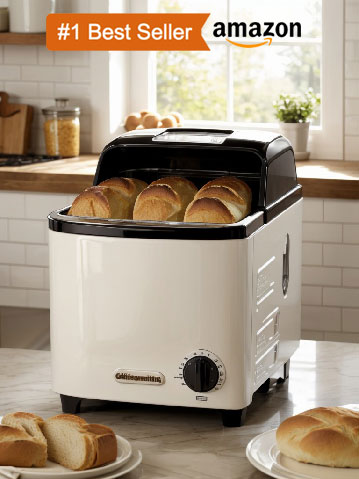Homemade White Bread Using A Bread Machine
Bread is a staple food throughout the world and making bread at home can be a great way to save money and ensure you are eating fresh, healthy ingredients. Baking bread in a bread machine is an easy way to make delicious homemade bread quickly and with minimal effort. This recipe for homemade white bread prepared in a bread machine will provide you with a delicious and fluffy loaf of bread.

Understand how your particular bread machine works and what settings it has available.
Understanding how a bread machine works is essential to getting the best results out of it. Each bread machine has different settings and features that can be used to customize the baking process. The most basic setting is a Bake setting, which is typically used to bake a loaf of bread from scratch.
This setting requires the user to add the ingredients in the appropriate order and select the desired bake time and temperature. Some machines may also have a Quick Bake setting which is used to bake a loaf of bread faster than the Bake setting. Other settings may include Dough Only which is used to prepare dough for baking in a conventional oven, Jam for making jam, Cake for baking cakes, and Yogurt for making yogurt. Some machines may also have settings for delay-start and pre-programmed recipes. Additionally, some machines may have a display that allows the user to view the progress of their bread-making process. By understanding how your particular bread machine works, you can make sure you get the best results out of it.
Make sure you have all the necessary ingredients, including yeast, on hand before starting your bread.
Having the right ingredients to make a loaf of bread is essential to ensure its success. Firstly, it is important to have the right type of flour. Bread flour is the best option as it has a higher protein content, which produces a chewier texture.
Secondly, yeast is an important ingredient in most bread recipes. It helps to activate the dough and give it a unique flavor and texture. Yeast can come in many forms, including instant dry yeast, active dry yeast, and fresh yeast. Thirdly, salt is an ingredient that adds flavor and helps to preserve the bread. Lastly, liquids are essential for activating the yeast and giving the dough structure. Water is the most common liquid used in bread recipes, but other liquids such as milk, butter, and vegetable oil can also be used to add flavor and texture. Making sure you have all the necessary ingredients before starting your bread will help ensure a delicious and successful loaf.
See also: What Kind Of Yeast To Use In Bread Machine
Measure the ingredients precisely to ensure your bread turns out properly.
Measuring ingredients precisely is essential for producing a successful loaf of bread. Taking the time to accurately measure each ingredient will ensure that your bread will turn out properly. It is important to use precise measurements when working with yeast, as even small variations can affect the rise and texture of the bread.
Flour should be measured by scooping the measuring cup into the flour and leveling it off with a knife. It is important not to tap or pack the flour in the measuring cup as this can result in too much flour being used. Salt and sugar should be measured with a spoon, lightly over filling the spoon before leveling it off. Yeast should be measured with a scale for accuracy. When measuring liquids, such as milk and water, use a liquid measuring cup and check the measurement at eye level. When measuring butter, it is best to use a kitchen scale to get an accurate measurement. Taking the time to precisely measure all of your ingredients will ensure that your bread turns out just as you intended.
See also: Gluten Free Quinoa Bread With Yeast In Bread Machine
Choose the right type of flour for your recipe all-purpose or bread flour is best.
When choosing the right flour for your recipe, it is important to consider the type of flour that will work best with the desired outcome. All-purpose flour is a great option for most baking needs, as it is a balanced blend of soft and hard wheat flours. It is great for making cakes, cookies, muffins, pancakes, and quick breads.
It also works well for pasta, sauces, and pie crusts. All-purpose flour has a moderate protein content (10-12%), which is important for creating a tender texture in baked goods. Bread flour is a great choice when you want a light and fluffy texture in your baked goods. It contains higher amounts of protein (12-14%) than all-purpose flour, which helps create more structure and rise in baked goods. Bread flour should be used when making yeast breads, pizza dough, rolls, and bagels. It will also give baked goods a slightly chewy texture. Overall, all-purpose flour is the most versatile and useful flour for baking. However, if you are looking for a specific texture or outcome with your recipe, it may be beneficial to use bread flour instead.
See also: Home Roasting Coffee In A Bread Machine What Temp
Use the correct amount of liquid for the recipe to get a moist, tender loaf.
When baking a loaf of bread, it is important to use the correct amount of liquid so that the finished product is moist and tender. Too much liquid will cause the bread to be overly soft and dense, while too little liquid will result in a dry and crumbly loaf. The amount of liquid used in a recipe will depend on the type of flour used, the desired texture of the finished product, and the other ingredients included in the recipe.
When measuring liquid for a bread recipe, it is best to use a measuring cup or spoon to ensure an accurate measurement. When adding liquid to a dry mixture, it is important to evenly distribute the liquid as to not create a wet spot in the dough. For best results, use just enough liquid so that all of the ingredients are evenly blended together and a moist dough is formed.
See also: The Complete Guide To Bread Machine Baking
Use the proper amount of sugar or honey to ensure the yeast activates properly.
In order to ensure that the yeast activates properly, it is important to use the proper amount of sugar or honey. Too little sugar or honey will not provide the yeast with enough energy to become active, while too much may kill the yeast or cause it to become dormant. The ideal amount of sugar or honey to use will depend on the type of yeast being used, as well as the recipe.
Generally, when using a dry active yeast, about one teaspoon of sugar or honey per cup of water is sufficient. If using a more delicate strain of yeast, such as a cake yeast, a slightly smaller amount may be necessary. In any case, it is important to understand the type of yeast, as well as the recipe requirements in order to determine the proper amount of sugar or honey for activation.
See also: What Setting Is White Bread On A Bread Machine
Make sure the yeast is fresh and activated before adding it to the ingredients.
When working with yeast, it is important to make sure that the yeast is fresh and activated before adding it to the ingredients. If the yeast is not fresh and activated, it may not be able to properly rise the dough and create the desired texture. To ensure the yeast is fresh, check the expiration date on the package and make sure it has not expired.
To activate the yeast, mix it with warm water and a small amount of sugar. Allow the mixture to rest for about 5-10 minutes. If the mixture begins to foam, the yeast is active and can be added to the ingredients. If not, discard the mixture and start again with fresh yeast. When adding the yeast to the ingredients, add it last and slowly incorporate it into the other ingredients. Following these steps will ensure that your dough rises properly and results in a delicious finished product.
Always knead the dough thoroughly to develop the gluten for a light texture.
Kneading the dough is an important step in bread making as it helps to develop the gluten, which is a protein found naturally in wheat flour. When you knead the dough, the gluten molecules begin to stretch and become more elastic. This elasticity will give the bread a light texture once it is baked.
To knead the dough properly, start by adding a small amount of flour to a clean work surface and spreading it out. Place the dough on top of the flour and begin to press down and flatten it with your hands. Then fold the dough over and turn it a quarter turn, repeating this process of pressing and turning until the dough becomes smooth and elastic. Kneading the dough should take between 5-10 minutes, depending on the type of bread you are making. It is important to knead the dough thoroughly so that it will rise properly while baking and produce a light, airy loaf of bread.
Allow the dough to rise in a warm, draft-free area until doubled in size.
For best results, allow the dough to rise in a warm, draft-free area. The ideal temperature should be around 75°F (24°C). To prevent drafts, you can put the dough in an oven that is slightly open, or in an enclosed area such as a cupboard.
Allow the dough to rise until it has doubled in size. Depending on the type of dough and the temperature of the environment, this could take anywhere from 1-2 hours. If you are using a yeast-based dough, you may notice bubbles beginning to form on the surface of the dough. This is a good sign that the dough is rising correctly. Once the dough has doubled in size, it is ready to be used.
Bake the bread on the correct setting and for the correct amount of time.
Baking bread is a science and an art. To ensure that your bread turns out perfectly, you need to bake it at the correct temperature and for the correct amount of time. Depending on the type of bread, the temperature will vary.
For most types of breads, a preheated oven at 350°F is ideal. You also need to consider the size of your loaf when determining how long to bake the bread. Generally, a small loaf should be baked for about 30 minutes, while a larger loaf may require up to 45 minutes. To test if the bread is done, insert a toothpick or skewer into the center. If it comes out clean, the bread is ready. If not, give it a few more minutes in the oven. Once the bread has finished baking, allow it to cool for several minutes before slicing and serving.





